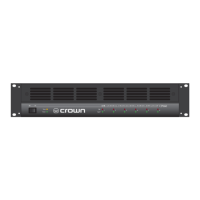Page 9
CP660 Six Channel Amplifier
Reference Manual
3 Installation
This section covers basic
CP660
installation proce-
dures. The
CP660
amplifier is intended for rack-mount
installations using a commercial 19-inch (48.3-cm) EIA-
rack-standard metal cabinet wired with a commercial-
grade electrical outlet box and receptacles.
3.1 Mounting
The
CP660
amplifier is designed for standard 19-inch
(48.3-cm) rack mounting or stacking without a cabinet.
In a rack, it is best to mount units directly on top of each
other. This provides the most efficient air flow and sup-
port. If the rack will be transported, we recommend that
you fasten the amplifier’s back panel securely to the
rack to help support the unit’s weight.
The
CP660
amplifier is 19 inches (48.3 cm) wide, 12
3
/
4
inches (32.3 cm) deep, and 3
1
/
2
inches (8.9 cm) high.
3.2 Cooling
It is important to understand cooling considerations
when installing the
CP660
amplifier. First, never block
the amplifier’s front air vents. This can cause poor air
power. This means you can expect the amplifier to re-
quire more air flow with a 4-ohm load than with an 8-
ohm load.
3.3 Wiring
Input and output terminals are located on the back panel.
Please use care when making connections, selecting sig-
nal sources and controlling the output level. The load you
save may be your own! Crown assumes no liability for dam-
aged loads resulting from careless amplifier use or deliber-
ate overpowering.
CAUTION: Always disconnect the AC power and turn
the level controls off when making or breaking connec-
tions. This is very important when loudspeakers are con-
nected because it reduces the chance of loud blasts that
can cause loudspeaker and/or hearing damage.
3.3.1 Mode of Operation
Proper wiring depends on your amplifier configuration.
Each pair of channels can be configured as a combined
channel (Mono mode) or separately (Dual mode). Because
of this flexibility, a number of combinations are possible
among all six channels, so be sure to note any special wir-
ing requirements for the configuration you will be using.
If one or more combined channels is required by your sys-
tem design, any adjoining pair of outputs (1,2: 3,4: 5,6) can
be configured for a Bridge mode of operation. To configure
your amp for Bridge mode, start by removing power from
the unit. Next, simply slide the switch on the appropriate
channels into “Mono” position.
DUAL MODE
Dual mode allows each amplifier channel to operate inde-
pendently like a typical stereo amplifier. Installation is intui-
tive: Input Channel 1 feeds output Channel 1, input
Channel 2 feeds output Channel 2, and so on.
Fig. 3.1 Top View of a Rack-Mounted Unit
flow and may result in overheating. If the amplifier is
rack-mounted, its sides should be at least 1
1
/
2
inches
(3.81 cm) away from the cabinet (see Figure 3.1). Also,
open spaces in the front of the rack should be covered
with solid blank panels to prevent improper air flow. Oth-
erwise, heated air from the rear exhaust can recirculate
and be drawn into the front air intake which may greatly
reduce the cooling system’s effectiveness.
Dust filters are not 100% efficient—depending on the
local environment, the internal heat sinks of the ampli-
fier will benefit from periodic cleaning by a qualified
technician. Internal cleaning information is available
from our Technical Support Group.
The air flow requirement for a
CP660
amplifier depends
on many things, but the most important factor is aver-
age output power. Air flow requirements increase as
output power increases, so anything that affects output
power also affects the required air flow.
In turn, average output power is mainly affected by two
considerations: (1) duty cycle of the input signal, and
(2) load impedance. First, as the duty cycle of the input
signal increases, the average output power level in-
creases. For example, the amplifier will need more air
flow with a rock ‘n’ roll input signal than with infrequent
paging. Second, as the load impedance of a connected
loudspeaker gets smaller, more current will flow through
the load, which effectively increases output power. This

